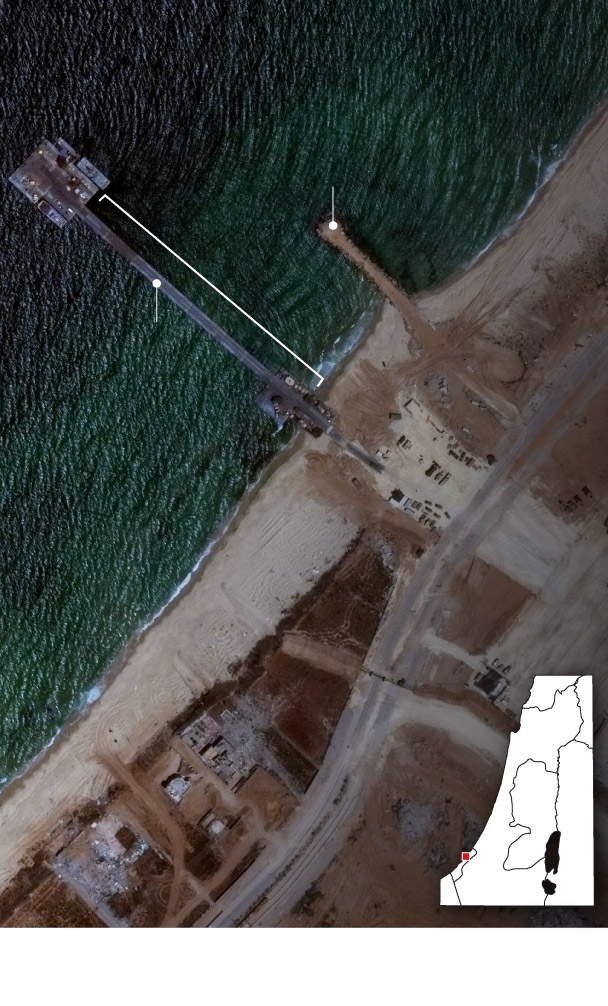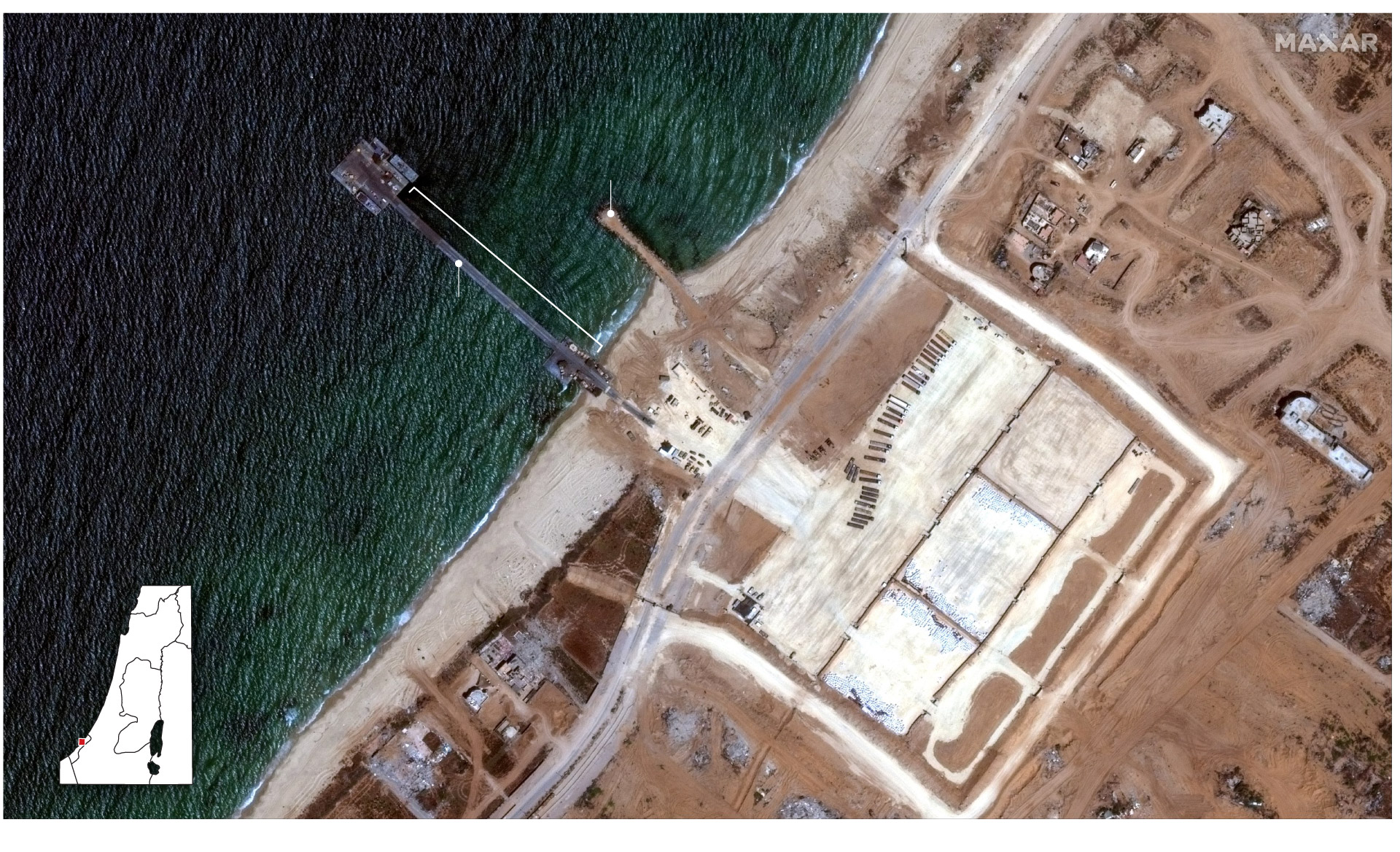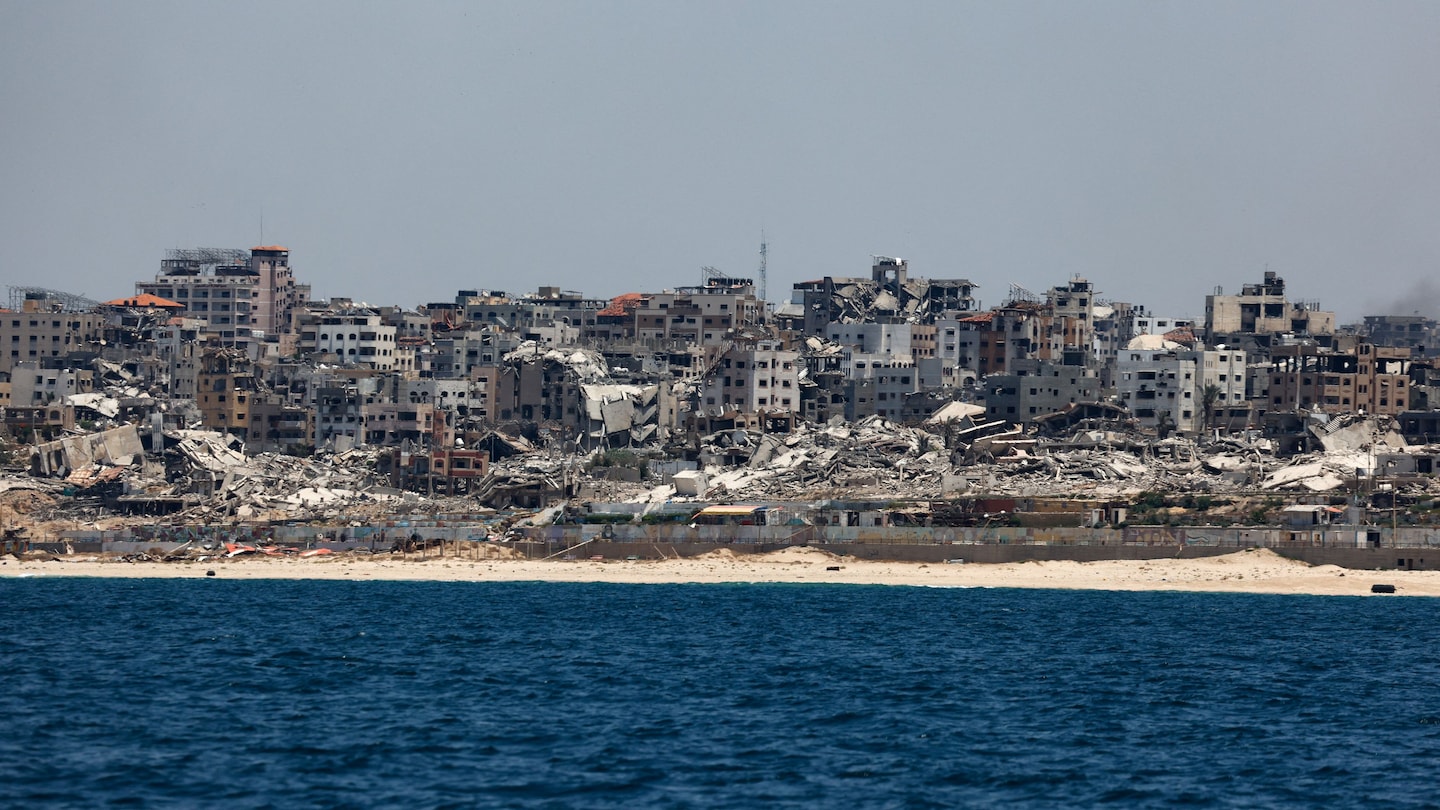A U.S.-built floating pier made for delivering aid to Gaza by sea that has been bedeviled by problems has once again been dismantled this weekend due to expected high seas, the Pentagon said.
“As always, the safety of our service members is a top priority, and temporarily relocating the pier will prevent potential structural damage that could be caused by the heightened sea state,” she said.
The pier was announced by President Biden in his March State of the Union address as part of a broader effort by his administration to get food and other lifesaving aid to starving Gazans as the humanitarian situation worsens and the enclave remains largely sealed off.
U.S. Central Command said that since May 17 it has assisted in the delivery of more than 8,831 metric tons of humanitarian aid to the shore of Gaza for onward distribution by humanitarian organizations. But aid groups estimate that the battered Gaza Strip requires hundreds of truckloads of aid a day to support the more than 2 million people trapped inside. Before the war, the daily average weight of goods delivered to the enclave on working days was about 7,500 tons.
Critics have argued that instead of constructing the pier, the United States could have delivered aid into Gaza faster and at less cost by pressuring the Israeli government to ease restrictions on aid moving through land routes.
GET CAUGHT UP
Stories to keep you informed
The pier is not an end-all solution to getting aid into Gaza, Singh said, adding that land routes are the most effective delivery method. “We continue to urge for those land routes to be reopened.”
Construction of the pier off the northwest Gaza coast was completed in May and the project cost an estimated $230 million. In late May, the pier was ripped apart by bad weather, causing an estimated $22 million in damage and sidelining the operation for days while it was repaired. Earlier in June, it was again partly dismantled and towed to shelter in Ashdod to avoid forecast bad weather, resuming operations about a week later. However, the restorations have done little to address questions about the ultimate effectiveness of the multimillion-dollar project, or whether it even could be scrapped.
Another hurdle has been the suspension of operations by the United Nations’ World Food Program, partly responsible for the distribution of aid arriving from the pier, after an Israeli hostage rescue operation on June 8 freed four hostages and left more than 250 Palestinians dead. WFP spokesman Steve Taravella told the Associated Press on Friday that U.N. participation in the pier is still on pause pending the resolution of security concerns.

Jetty built by World
Central Kitchen
Source: Maxar Technologies/Handout via REUTERS
SAMUEL GRANADOS / THE WASHINGTON POST

Jetty built by World
Central Kitchen
Source: Maxar Technologies/Handout via REUTERS
SAMUEL GRANADOS / THE WASHINGTON POST

Jetty built by World
Central Kitchen
Source: Maxar Technologies/Handout via REUTERS
SAMUEL GRANADOS / THE WASHINGTON POST

Jetty built by World
Central Kitchen
Source: Maxar Technologies/Handout via REUTERS
SAMUEL GRANADOS / THE WASHINGTON POST
It comes as the United Nations warned that “access constraints — coupled with insecurity and ongoing hostilities — continue to significantly impede the delivery of essential humanitarian assistance and services across Gaza,” Stéphane Dujarric, spokesman for the U.N. secretary general, told reporters Friday.
“This includes critical food and nutrition aid, medical care, shelter support, and water, sanitation, and hygiene services for hundreds of thousands of people in need.”
Dujarric also said there had been “at least 60,000 people” displaced from the Shejaiya area east of Gaza City in recent days. He added that U.N. teams were trying to deliver aid despite constraints. “Whenever there is an opportunity for us and the safety and security of the recipients and if our staff allows it, we will help them,” he added.
The Gaza Civil Defense force said in an update on Saturday that it had “received many appeals from families who have been besieged in the Shejaiya neighborhood for three days” and appealed to international aid agencies to do more.
The Israel Defense Forces said in an update Saturday that its troops “are continuing operational activity” in the Shejaiya area, “fighting simultaneously above and below ground.” The IDF said it had killed “a large number” of fighters and “located a weapons storage facility within a school compound in the area.” The Washington Post could not independently verify the claims.
Earlier this week, Israeli forces ordered residents to evacuate the Shejaiya neighborhood, which was the site of fierce fighting earlier in the war, while footage shared on social media appeared showed residents fleeing on foot and bicycle. It is the latest area of northern Gaza where Israeli forces have returned to battle after pulling out months earlier.
Here’s what else to know
A police officer guarding the Israeli embassy in Belgrade, Serbia, was attacked with a crossbow on Saturday, the Associated Press reported. Serbia’s Interior Minister Ivica Dacic told the outlet the officer in turn “used a weapon in self-defense to shoot the attacker, who died as a result of his injuries.” The officer was conscious when he was transported to hospital, it added. Israel’s Foreign Ministry called it an “an attempted terrorist attack,” adding that the embassy is closed and no employees were injured. “The circumstances of the incident are being investigated,” it said.
Iran’s mission to the United Nations warned of “an obliterating war” if Israel embarks on “full-scale military aggression” in Lebanon. The mission added in a post on X that “all options” were on the table and criticized what it called Israeli “propaganda about intending to attack Lebanon” as “psychological warfare.” Hezbollah, the Iranian-backed Lebanese militant group, political party and ally of Hamas, has repeatedly said that a halt to Israel’s offensive in Gaza is needed before its fighters will stand down. U.S. officials have said they are working to quiet fighting between Israel and Hezbollah that has pushed Lebanon to the brink of war.
More than 115,000 Gazans have crossed into Egypt since October, the Palestinian Authority’s embassy in Egypt estimates. Several thousand sick and wounded have been treated in Egyptian hospitals, while the vast majority of evacuees came with the help of foreign embassies or through tourism services. Most refugees remain in limbo, with no legal status and nowhere else to go. Washington Post reporters visited displaced Gazans at their homes and workplaces around Cairo.
The Gaza war was mentioned in this week’s U.S. presidential debate. “We are the biggest producer of support for Israel in the world,” President Biden said, adding: “Hamas cannot be allowed to continue.” Former president Donald Trump argued that Israel should be enabled to “finish the job.” He said Biden has “become like a Palestinian but they don’t like him because he’s a very bad Palestinian, he’s a weak one.”
At least 37,834 people have been killed and 86,858 injured in Gaza since the war started, according to the Gaza Health Ministry on Saturday. It does not distinguish between civilians and combatants but says the majority of the dead are women and children. Israel estimates that about 1,200 people were killed in Hamas’s Oct. 7 attack, including more than 300 soldiers, and it says 314 soldiers have been killed since the start of its military operations in Gaza.
Miriam Berger and Alon Rom contributed to this report.

